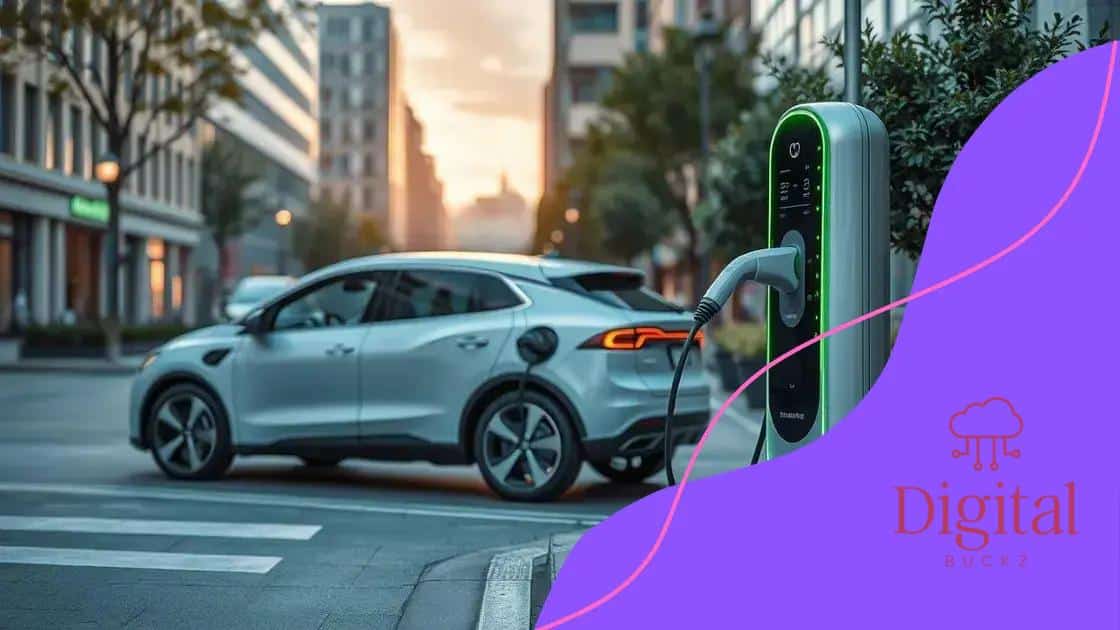The impact of electric vehicles on the automotive industry

The impact of electric vehicles on the automotive industry includes increased demand for sustainable transport, government incentives, advancements in technology, and a shift towards cleaner alternatives that reduce emissions and operational costs.
The impact of electric vehicles on the automotive industry is undeniable as the world shifts towards sustainable transportation. Have you wondered how these vehicles are changing the landscape of driving? Let’s dive into the details.
Understanding electric vehicles and their technology
Understanding electric vehicles (EVs) is crucial as they become more prevalent on our roads. With unique technology, these vehicles offer a glimpse into a sustainable future that many are eager to embrace.
Electric vehicles operate using electric motors, rather than traditional internal combustion engines. This means they rely on batteries to power their movement, which can provide new efficiencies in energy usage. Because of this technology, EVs can significantly reduce greenhouse gas emissions, paving the way for a cleaner environment.
Key Components of Electric Vehicles
Several components make up the heart of EV technology:
- Batteries: The energy stored in these batteries powers the vehicle.
- Electric Motor: This drives the wheels using electrical energy instead of gasoline.
- Charging System: EVs need charging stations to replenish their energy supply, just as gas stations do for traditional vehicles.
- Regenerative Braking: This technology helps recharge the battery when the vehicle slows down, improving efficiency.
As more manufacturers pivot toward electric options, the infrastructure around EVs is also expanding. Cities are increasingly installing charging stations, making it easier for drivers to transition. This shift supports a broader vision of sustainable transportation that many hope to see in the near future.
Fascination with electric vehicles is growing daily. Consumers find themselves curious about owning an EV due to benefits like reduced fuel costs and lesser environmental impact. Additionally, governments worldwide are supporting this transition through incentives and subsidies. Therefore, understanding the advantages and technology behind electric vehicles is essential for consumers making informed decisions.
Advantages of electric vehicles for consumers
Electric vehicles (EVs) offer numerous advantages for consumers looking to make a change in their driving habits. As more people become environmentally conscious, many are turning to electric vehicles for their benefits.
One of the most appealing advantages is the cost savings associated with owning an EV. With lower fuel costs, drivers can save money on energy compared to traditional gasoline-powered vehicles. Many EV owners report spending a fraction of what they used to on fuel, making it an economical choice.
Key Benefits of Electric Vehicles
Here are some key advantages that consumers enjoy when they choose electric:
- Environmental impact: EVs produce no tailpipe emissions, helping to reduce air pollution.
- Tax incentives: Many governments offer benefits such as tax credits or rebates for purchasing electric vehicles.
- Lower maintenance costs: With fewer moving parts, EVs often require less frequent maintenance than traditional vehicles.
- Quiet operation: Electric vehicles operate quietly, contributing to less noise pollution.
Additionally, as technology continues to advance, the performance of electric vehicles improves. Consumers can now find models that provide impressive acceleration and range. This progress makes EVs attractive options for drivers who may have previously favored gasoline vehicles.
Moreover, with charging stations becoming more widespread, the convenience of owning an electric vehicle increases. Drivers can charge their cars at home, at work, or while shopping, making it easy to keep their vehicles powered. The growing infrastructure supports a shift to electric mobility, further enticing consumers.
Challenges faced by the automotive industry

The automotive industry currently wrestles with several challenges as it adapts to the era of electric vehicles (EVs). These challenges affect manufacturers, consumers, and the environment alike.
One major obstacle is transitioning production from traditional vehicles to electric models. Manufacturers must invest heavily in new technology and infrastructure. This shift can be costly and may lead to job losses in sectors focused on internal combustion engines.
Key Challenges in the Automotive Industry
Here are some of the significant challenges facing the automotive industry today:
- Supply chain issues: As demand for electric vehicles grows, there is increasing pressure to secure materials like lithium and cobalt for batteries.
- Regulatory pressures: Governments worldwide are imposing stricter emissions regulations, forcing manufacturers to accelerate their transition to EVs.
- Consumer education: Many potential buyers are still unfamiliar with electric vehicles and their benefits, making consumer outreach essential.
- Charging infrastructure: Expanding charging networks is vital to support the growing number of electric vehicles on the road.
Furthermore, the automotive industry must contend with competition from both established companies and new entrants. Traditional carmakers are facing pressure from tech companies that are entering the EV space. These tech-focused firms often have innovative ideas and can meet consumer needs in ways traditional manufacturers might not.
As the industry navigates these challenges, it must also consider the implications for sustainability and environmental responsibility. Striking a balance between profitability and eco-friendliness is essential for the future of the automotive sector. Consumers want to support brands that contribute to a greener planet, and manufacturers must keep this in mind.
Future trends in electric vehicle development
The future of electric vehicle (EV) development looks promising and dynamic. With advancements in technology and growing consumer demand, the automotive industry is preparing for significant changes.
One major trend is the increasing range of electric vehicles. As battery technology improves, consumers can expect to drive farther on a single charge. This innovation can alleviate concerns about running out of battery during long trips.
Emerging Trends in Electric Vehicles
Several key trends are shaping the future of electric vehicles:
- Autonomous driving: Manufacturers are investing in autonomous technology, aiming to create fully self-driving electric vehicles in the future.
- Smart technology integration: EVs will feature more connected technology, allowing for features like real-time traffic updates and remote diagnostics.
- Vehicle-to-grid systems: These systems enable electric vehicles to supply power back to the grid, helping to stabilize energy demand.
- Affordability: As production scales up, the cost of electric vehicles is expected to decrease, making them accessible to a wider audience.
Additionally, partnerships between automotive manufacturers and tech companies are becoming more common. Companies that specialize in software are collaborating with traditional carmakers to enhance the tech features in electric vehicles. This trend may lead to smarter, safer, and more efficient EVs.
Moreover, government policies worldwide are adapting to support electric vehicle adoption. Incentives for buying EVs are likely to increase, encouraging more consumers to make the switch. Public awareness campaigns will continue to inform people about the advantages of electric mobility.
The role of government policies in promoting EVs
Government policies play a vital role in promoting electric vehicles (EVs) and shaping the future of transportation. By implementing effective regulations and incentives, governments can encourage more people to switch from traditional gasoline-powered cars to electric vehicles.
One significant way that governments support EV adoption is through financial incentives. These incentives may include tax credits, rebates, or grants for consumers who purchase electric vehicles. Such financial relief can make EVs more affordable for the average consumer, driving up sales and encouraging manufacturers to invest in electric technology.
Key Government Actions for Promoting EVs
There are several strategies that governments use to encourage the adoption of electric vehicles:
- Building charging infrastructure: Governments often invest in charging stations that make it easier for EV owners to recharge their vehicles.
- Setting emissions regulations: Stricter emissions standards can push auto manufacturers to produce more electric and hybrid models.
- Offering research and development grants: Public funding for research in battery technology and EV innovation aids manufacturers in developing better products.
- Public awareness campaigns: Government initiatives help educate citizens about the benefits of electric vehicles, encouraging more people to consider making the switch.
Moreover, international agreements are also influencing domestic policies. Many governments are committing to reducing carbon emissions as part of global efforts to combat climate change. By setting ambitious targets for EV adoption, they create environments that favor electric vehicle growth.
As these policies take shape, the market for electric vehicles continues to expand. With increasing support from governments, the prospects for widespread EV adoption look bright. These policies are critical not just for the automotive industry but also for improving air quality and reducing dependence on fossil fuels.
The transition to electric vehicles (EVs) is not just a trend; it represents a significant shift in the automotive industry. With government support, advances in technology, and growing consumer interest, the future of EVs looks promising. As consumers become more informed about the benefits of electric vehicles, such as cost savings and environmental impact, adoption is likely to increase. The automotive industry is at a crossroads, and embracing these changes will lead to a cleaner and more sustainable transportation system for everyone.
FAQ – Frequently Asked Questions about Electric Vehicles
What are the main benefits of electric vehicles?
Electric vehicles offer lower fuel costs, reduced maintenance expenses, and fewer emissions, making them better for the environment and your wallet.
How do government policies support electric vehicle adoption?
Governments provide incentives like tax credits, rebates, and invest in charging infrastructure to encourage more people to choose electric vehicles.
What advancements are being made in battery technology?
Battery technology is rapidly improving, leading to longer ranges, faster charging times, and lower costs for electric vehicles.
How can I charge my electric vehicle?
You can charge your electric vehicle at home using a dedicated charging station, at public charging stations, or at work if available.






